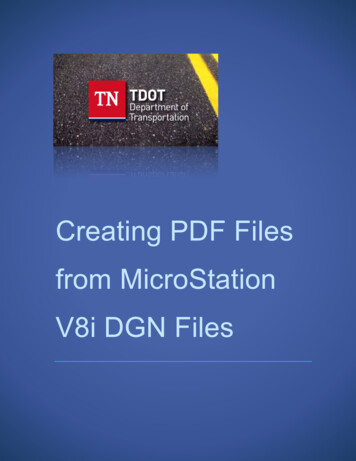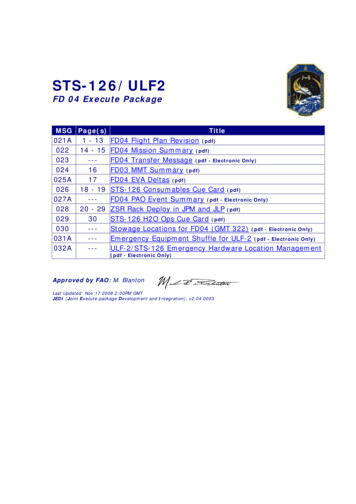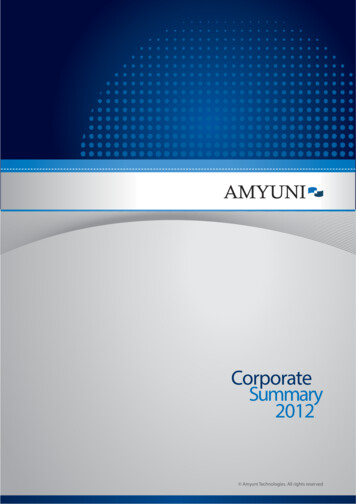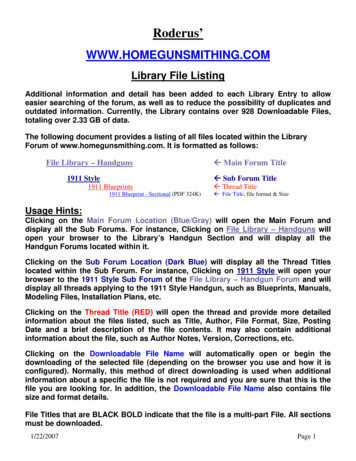
Transcription
This PDF is made available under a Creative CommonsAttribution-NonCommercial-NoDerivatives 4.0International (CC BY-NC-ND 4.0) Licence. Further detailsregarding permitted usage can be found at rint and ebook editions of this work are available topurchase from Zed Books (zedbooks.net).
A frica NowAfrica Now is published by Zed Books in association with theinternationally respected Nordic Africa Institute. Featuring high-quality,cutting-edge research from leading academics, the series addresses the bigissues confronting Africa today. Accessible but in-depth, and wide-rangingin its scope, Africa Now engages with the critical political, economic,sociological and development debates affecting the continent, shedding newlight on pressing concerns.Nordic Africa InstituteThe Nordic Africa Institute (Nordiska Afrikainstitutet) is a centre forresearch, documentation and information on modern Africa. Based inUppsala, Sweden, the Institute is dedicated to providing timely, critical andalternative research and analysis of Africa and to co-operation with Africanresearchers. As a hub and a meeting place for a growing field of researchand analysis the Institute strives to put knowledge of African issues withinreach for scholars, policy makers, politicians, media, students and thegeneral public.www.nai.uu.se
Forthcoming titlesAtakilte Beyene (ed.), Agricultural Transformation in EthiopiaLaura Stark and Annika Teppo (eds), Power and Inequality in Urban AfricaTitles already publishedFantu Cheru and Cyril Obi (eds), The Rise of China and India in AfricaIlda Lindell (ed.), Africa’s Informal WorkersIman Hashim and Dorte Thorsen, Child Migration in AfricaProsper B. Matondi, Kjell Havnevik and Atakilte Beyene (eds), Biofuels,Land Grabbing and Food Security in AfricaCyril Obi and Siri Aas Rustad (eds), Oil and Insurgency in the Niger DeltaMats Utas (ed.), African Conflicts and Informal PowerProsper B. Matondi, Zimbabwe’s Fast Track Land ReformMaria Eriksson Baaz and Maria Stern, Sexual Violence as a Weapon of War?Fantu Cheru and Renu Modi (eds), Agricultural Development and FoodSecurity in AfricaAmanda Hammar (ed.), Displacement Economies in AfricaMary Njeri Kinyanjui, Women and the Informal Economy in Urban AfricaLiisa Laakso and Petri Hautaniemi (eds), Diasporas, Development andPeacemaking in the Horn of AfricaMargaret Lee, Africa’s World TradeGodwin R. Murunga, Duncan Okello and Anders Sjögren (eds), Kenya: TheStruggle for a New Constitutional OrderLisa Åkesson and Maria Eriksson Baaz (eds), Africa’s Return MigrantsThiven Reddy, South Africa: Settler Colonialism and the Failures of LiberalDemocracyCedric de Coning, Linnéa Gelot and John Karlsrud (eds), The Future ofAfrican Peace OperationsTobias Hagmann and Filip Reyntjens (eds), Aid and Authoritarianism inAfricaHenning Melber, The Rise of Africa’s Middle ClassAnders Themnér (ed.), Warlord Democrats in AfricaPaul Higate and Mats Utas (eds), Private Security in Africa
About the editorsMimmi Söderberg Kovacs is Head of Research at the Folke BernadotteAcademy (FBA) and affiliated Senior Researcher with the Nordic AfricaInstitute (NAI) and the Department of Peace and Conflict Research at UppsalaUniversity in Sweden. Her research focus is on non-state actors in civilwars, rebel-to-party transformations, conflict resolution, peace processes, andpost-war democratisation.Jesper Bjarnesen is Senior Researcher at the Nordic Africa Institute (NAI).His main research area is qualitative migration studies, with a focus on theoverlaps between voluntary and involuntary movements; the dynamics ofmobility in relation to armed conflict; and the micro-politics of inclusion andexclusion in urban contexts in West Africa.
Violence in African ElectionsBetween Democracy and Big Man Politicsedited by Mimmi Söderberg Kovacs and Jesper Bjarnesen
Violence in African Elections: Between Democracy and Big Man Politicswas first published in association with the Nordic Africa Institute,PO Box 1703, SE-751 47 Uppsala, Sweden in 2018 by Zed Books Ltd,The Foundry, 17 Oval Way, London SE11 5RR, UK.www.zedbooks.netwww.nai.uu.seEditorial copyright Mimmi Söderberg Kovacs and Jesper Bjarnesen 2018Copyright in this collection Zed Books 2018The rights of Mimmi Söderberg Kovacs and Jesper Bjarnesen to beidentified as the editors of this work have been asserted by them inaccordance with the Copyright, Designs and Patents Act 1988.Typeset in Minion Pro by seagulls.netIndex by John BarkerCover design by Alice MarwickCover photo Sven Torfinn/PanosAll rights reserved. No part of this publication may be reproduced,stored in a retrieval system or transmitted in any form or by anymeans, electronic, mechanical, photocopying or otherwise, withoutthe prior permission of Zed Books Ltd.A catalogue record for this book is available from the British �1 hb978‑1‑78699‑228‑4 pb978‑1‑78699‑230‑7 pdf978‑1‑78699‑231‑4 epub978‑1‑78699‑232‑1 mobi
ContentsAbbreviations ixAcknowledgements xiiiIntroduction: The everyday politics of electoral violence in Africa . . . 1mimmi söderberg kovacs1Ethnic politics and elite competition: the roots of electoral . . . . .violence in Kenya27hanne fjelde and kristine höglund2Wielding the stick again: the rise and fall and rise of state . . . . . . 47violence during presidential elections in Ugandaanders sjögren3Land conflict and electoral violence in Côte d’Ivoire: . . . . . . . . 67a micro-level analysismatthew i. mitchell4The geography of violence in Burundi’s 2015 elections . . . . . . . . 87willy nindorera and jesper bjarnesen5Competition, uncertainty and violence in Sierra Leone’s . . . . . . 114swing districtibrahim bangura and mimmi söderberg kovacs6Ex-militants and electoral violence in Nigeria’s Niger Delta . . . . . 135tarila marclint ebiede
7The winner takes it all: post-war rebel networks, Big Man politics, . . 156and the threat of violence in the 2011 Liberian electionsmariam bjarnesen8Parasitic politics: violence, deception and change in Kenya’s . . . . 176electoral politicsjacob rasmussen9Eclectic ties and election touts: Chipangano’s cyclic . . . . . . . . 197governance agenda in Mbare, Zimbabwetariro mutongwizo10Patronage politics and electoral violence in Lagos, Nigeria: . . . . . . 215understanding the micro-level dynamicsdaniel e. agbiboa11‘Once they all pick their guns you can have your way’: . . . . . . . 233campaigning and talking about violence in northern Ghanaafra schmitzConclusion: Beyond democracy and Big Man politics . . . . . . . 250jesper bjarnesen and mimmi söderberg kovacsAbout the contributors 263Index 264
AbbreviationsAFRCArmed Forces Revolutionary Council (Sierra Leone)ANACOWA All Nigerians Autobike Commercial Owners and WorkersAssociation of NigeriaAll People’s Congress (Sierra Leone)APCAPCAll Progressives Congress (Nigeria)CDCCongress of Democratic Change (Liberia)CENAPConflict Alert and Prevention Centre (Burundi)CHRACombined Harare Residents’ Association (Zimbabwe)CNDD-FDD National Council for the Defence of Democracy and theForces for the Defence of Democracy (Burundi)CNTBNational Commission on Land and Other Assets (Burundi)CODEOCoalition of Domestic Election Observers (Ghana)CORDCoalition for Reforms and Democracy (Kenya)DCEDistrict Chief Executive (Ghana)DDRdisarmament, demobilisation and reintegrationDDRRdisarmament, demobilisation, rehabilitation and reintegrationDPDemocratic Party (Kenya / Uganda)ECOWASEconomic Community of West African StatesFDCForum for Democratic Change (Uganda)FNLNational Forces of Liberation (Burundi)FORDForum for the Restoration of Democracy (Kenya)FPIIvorian Popular Front (Côte d’Ivoire)FRODEBUFront for Democracy in BurundiGEMAGikuyu, Embu, Meru Association (Kenya)GPAglobal political agreement (Zimbabwe)HRTHarare Residents’ Trust (Zimbabwe)ICCInternational Criminal CourtIEBCIndependent Electoral and Boundaries Commission (Kenya)INPFLIndependent National Patriotic Front of LiberiaIOCinternational oil company (Nigeria)JIAMJesus Is Alive Ministries (Kenya)KADUKenyan National Democratic UnionKAIKick Against Indiscipline (Nigeria)KAMATUSA Kalenjin, Maasai, Turkana, Samburu Association (Kenya)KANUKenyan African National Unionix
no Progressive Movement (Sierra Leone)Kenya People’s UnionLiberian National PoliceLiberians United for Reconciliation and DemocracyMilitary Aid to Civil Power (Sierra Leone)Movement for Democratic Change (Zimbabwe)Movement for the Emancipation of the Niger Delta (Nigeria)Movement for Democracy in Liberiamember of parliamentMovement for Solidarity and Development (Burundi)National Rainbow Coalition (Kenya)National Democratic Congress (Ghana)Niger Delta Development Commission (Nigeria)National Democratic Party of LiberiaNiger Delta People’s Volunteer Force (Nigeria)Niger Delta Vigilante (Nigeria)National Electoral Commission (Sierra Leone)Nigerian Maritime Safety AgencyNigerian National Petroleum CompanyNational Peace Council (Ghana)National Patriotic Front of LiberiaNational Party of NigeriaNew Patriotic Party (Ghana)National Patriotic Party (Liberia)National Provisional Ruling Council (Sierra Leone)National Resistance Army (Uganda)National Resistance Movement (Uganda)National Transitional Government of LiberiaNational Union for Democratic Progress (Liberia)National Union of Road Transport Workers (Nigeria)Office of National Security (Sierra Leone)Partners for Peace (Nigeria)Presidential Amnesty Programme (Nigeria)People’s Democratic Party (Nigeria)People’s Movement for Democratic Change (Sierra Leone)Provisional National Defence Council (Ghana)Party of National Unity (Kenya)Political Party Registration Commission (Sierra Leone)Reform Agenda (Uganda)Radio France InternationaleRadio Publique Africaine (Burundi)Revolutionary United Front (Sierra Leone)x
Sierra Leone People’s PartyUnited NationsUnited Nations Mission in LiberiaUnity Party (Liberia)Uganda People’s CongressUganda Peoples Defence ForcesUnity Party of NigeriaUnion for National Progress (Burundi)West Africa Network for PeacebuildingZimbabwe African National Union Patriotic FrontZimbabwe African People’s UnionZimbabwe People ANEPZANU-PFZAPUZimPF
AcknowledgementsThe first steps towards the writing of this book were taken in October 2015 withthe organisation of a two-day writers’ workshop at the Nordic Africa Institute(NAI) on this theme. During intense discussions, patterns and trends beganto emerge across the different case studies of electoral violence in Africa thatwere presented, and many of the gaps that we try to address in this volumewere identified. We owe a great deal to all those scholars who participatedin the workshop but are not included in this book, notably Akin Iwilade,Ayokunle O. Omobowale, Azeez O. Olaniyan, Charly D. N. Tsafack, FelixKumah-Abiwu, Johanna Riess, Michael N. Mbapndah, Olatokunbo O. Fayiga,Olusoji A. Odeyemi, Osita Odafi, Rodrick Henry and Surajudeen O. Mudasiro.We are also grateful to colleagues outside the author circle who providedinsightful comments on some of the chapters, notably Anders Themnér, AngelaMuvumba Sellström, Henrik Angerbrandt and Johan Brosché. The SwedishResearch Council financially supported the writers’ workshop, as well as theproduction of this book, within the framework of a major research grant.Funding for the workshop was also generously provided by NAI, and we wereable to benefit from much appreciated administrative assistance in the form ofAnnika Franklin’s expertise. We are truly indebted to both institutions, withoutwhose support this book project could not have been completed.Several of the ideas expressed in this book also benefited from years ofdiscussions and stimulating intellectual exchange with our research colleaguesat NAI, not least in the dynamic research cluster on Conflict, Security andDemocratic Transformation. Perhaps more than anyone, we would like tothank Mats Utas for first opening the door for us at NAI and successfullynurturing a space for productive interdisciplinary research on contemporaryAfrican studies. We would also like to extend our appreciation to formerDirector Carin Norberg for accepting to host the research grant at NAI inthe first place, and to current Director Iina Soiri and Head of Research VictorAdetula for their continuous support. We are also grateful to NAI’s formerHead of Communications Elnaz Alizadeh for supporting our initial idea of anedited volume on this theme. During the writing of this volume, we have alsorelied on meticulous assistance from Henrik Persson at NAI and Sophia Wredeat the Folke Bernadotte Academy (FBA). We received insightful commentsfrom Kristine Höglund at the Department of Peace and Conflict Research atUppsala University on the introductory chapter, and several other colleaguesxiii
and conference participants have provided useful input and advice on variousparts of the book. We would also like to highlight the constructive and veryuseful comments provided by two anonymous reviewers. Their suggestionssignificantly helped us in strengthening our arguments and sharpening ourcontributions. We would also like to extend our appreciation to the team atZed Books and especially to Ken Barlow, editor of the Africa Now series, forhis enthusiasm and unwavering support. We have also benefited considerablyfrom Judith Forshaw’s perceptive copyediting of this text, and Henrik Alfredsson’s tireless work in designing the maps for chapter 4.Above all, we would like to say thank you to all the chapter authors, whotook time out of busy schedules and demanding work piles to join us in thiscollaborative and interdisciplinary effort on violence in African elections.Mimmi Söderberg KovacsJesper BjarnesenUppsala, December 2017xiv
Introduction: The everyday politics ofelectoral violence in AfricaMimmi Söderberg Kovacs‘Ampa ampoh,’ yell the young men sitting on the back of the pickup truck thathastily enters the back gate of the State House building in downtown Freetownin Sierra Leone. It means ‘It is over’ in Temne, one of the local languages. It islate in the afternoon of Friday 24 November 2012, and the National ElectionCommission (NEC) has just held a press conference to announce the results ofthe presidential elections, ending days of intense speculation after the closingof the polls. According to the announcement, the sitting president Ernest BaiKoroma of the All People’s Congress (APC) has secured a second term in poweragainst Julius Maada Bio, the flag-bearer of the Sierra Leone People’s Party(SLPP). Many hoped that this would be the end of a tense and occasionallyviolent election campaign. However, while APC supporters dressed in red(the party colour) danced in the streets of Freetown, cheering and singingamidst the ear-deafening sounds of car horns, whistle pipes and the bangingof pots and pans, disgruntlement was mounting in the opposition camp. Thefollowing day, the SLPP accused the incumbent of electoral fraud, refusing toaccept the results. The next few weeks saw several minor incidents of violenceacross the country, especially in traditional SLPP strongholds, as young partysupporters took to the streets, clashed with the police and security personnel,and engaged in local fights against APC supporters. It was not until the SLPPleadership eventually conceded its electoral defeat a few weeks later that theviolence finally subsided (Söderberg Kovacs 2012).The example above reflects a larger trend that we have witnessed in subSaharan Africa since the (re-)introduction of multiparty democracy in theearly 1990s. In a relatively short time period, democracy has formally beenestablished as the dominant political system across the continent, and theholding of elections has emerged as the most important institutional mechanism for the distribution of political power. Other means and methods ofpolitical rule have grown increasingly difficult to motivate and sustain in theface of changing normative and institutional frameworks at both the global andthe regional level. Yet, at the same time, we have witnessed a growing trendof electoral violence in many new democracies. According to Burchard (2015:50), more than half of Africa’s states, 55 per cent, have experienced electoral1
violence in the post-Cold War period. Importantly, beyond the relatively fewcases of large-scale killings and widespread fear and insecurity that makeit to the international headlines – such as in Kenya in 2007, Zimbabwe in2008 and Côte d’Ivoire in 2010 – a more common scenario has been thatof isolated violent events, harassment and coercive intimidation. Countriesthat have displayed such characteristics during election periods include, forexample, Cameroon, the Democratic Republic of Congo, Liberia, EquatorialGuinea, the Gambia, Guinea, Madagascar, Sierra Leone, Senegal and Uganda(Straus and Taylor 2012).In addition, and often forgotten both by the international media and bythe scholarly community engaged in better understanding the phenomenon, amultitude of countries experience the kind of electoral violence that is low-scalebut pervasive and typically occurs long before the elections, between electoralcycles, and in local elections far from the international limelight. MacGinty(2014) introduced the term ‘everyday peace’ to capture the routinised practicesand norms deployed by individuals and groups to navigate their way throughlife in divided societies. This is a scholarly approach that emphasises bottom-upperspectives on a social phenomenon and takes seriously the notion of localagency (see also Autesserre 2010). We find this inspirational, and would like toevoke the expression of ‘everyday politics of electoral violence’ to characterisethe overall perspective employed in this book. Most individuals and groups inAfrica’s electoral democracies are likely to find concepts such as ‘competitiveelections’ and ‘patronage politics’ to be of little use for describing their everydayexperiences. However, their everyday realities can assist us in better understanding the specific and localised expressions of these theoretical conceptsand contribute to a more deep-layered understanding of the phenomenonof electoral violence. Importantly, the ‘bottom-up’ perspective is not put incontrast or opposition to the ‘top-down’. Instead, the two views inform eachother, and we have deliberately put together a collection of contributions thattogether and jointly highlight both perspectives.The example given above from the 2012 general elections in Sierra Leoneis particularly interesting in this respect because it was generally considereda very successful election according to most traditional international criteria.For example, the national electoral institutions acknowledged only a handful ofelectoral irregularities. Very limited evidence of over-voting or ballot stuffingwas discovered. The large number of international and domestic electionobserver teams all declared the elections free of systematic malpractice. Yet,at the same time, there is little doubt that the elections were conducted onan uneven playing field, where the incumbent was able to take significantadvantage of his position in power, for example in terms of access to themedia and to resources for campaigning. In addition, the heavy and visiblepresence of both the police and the military patrolling the streets during the2
3Introductionelection period did not always instil a sense of security among the population.Rather, for some it was a cause of provocation and a sign that the APC wasconflating the party with the state (Söderberg Kovacs 2012). As if to furtherunderscore this point, both the dominant public discourse and the languageand terminology used by the parties were frequently cloaked in symbolismassociated with battle and warfare. For example, Maada Bio was hailed as ‘theTormentor’ by his supporters, in reference to his past as a military junta leaderin the coup that overthrew the one-party APC regime at the beginning of thecivil war in 1992 (Bangura and Söderberg Kovacs 2017). Maada Bio’s transformation from wartime leader to political party representative running for officeis not unique. A large number of post-war African states have witnessed theemergence of so-called ‘warlord democrats’: former military or political leadersof armed groups who subsequently participate in electoral politics (Themnér2017). There are thus many good reasons for suggesting that elections havebecome ‘the new battlegrounds’ (Bøås and Utas 2014).The threats associated with electoral violence are many. Beyond the immediate human, material and societal costs that such violence imposes on alreadyimpoverished and sometimes war-torn states, it also risks undermining thelegitimacy of the electoral process and the democratic political system. Researchshows that electoral violence is significantly related to individual assessmentsabout willingness to vote, democratic satisfaction, support for democracy andtrust in governing institutions (Burchard 2015). Violence and voter intimidationhave also been found to reduce voter turnouts in some elections (Bratton 2008;Collier and Vicente 2008), although more recent research suggests that thereare no such effects of violence on voter turnout more generally in Africanelections (Bekoe and Burchard 2017). Electoral violence also risks permeatingcycles of revenge between political parties at the local level (Höglund andPiyarathne 2009). In countries where the winner literally takes all, the stakesof elections are high, and the costs of defeat devastating. Whether you are theflag-bearer of the party or an ex-soldier or ex-militia working behind the scenesas part of the security task force of a political party, a loss at the polls meansanother few years out in the cold, another few years of struggle for survivaland for access to resources (Christensen and Utas 2016). In some exceptionalcases, elections may even be an impetus for civil war, as the developmentsin Burundi in 2015 amply illustrated. Even if such instances are rare, whenthey do happen they can also affect neighbouring states through large-scaledisplacement of people, the creation of a humanitarian crisis, and the increasingcirculation of arms in already volatile regions.Following in the footsteps of this development, an emerging and fast-growingresearch agenda has developed that seeks to better understand the causes,dynamics and consequences of electoral violence. In this debate, several criticalgeneric factors have been identified as explanations for why some countries are
more likely than others to experience such violence (e.g. Fjelde and Höglund2014; Hafner-Burton, Hyde and Jablonski 2013; Norris, Frank and Martinez iComa 2015; Salehyan and Linebarger 2015). While such studies are important inidentifying those countries most at risk, and while they can help us understandwhat characteristics of the political system in place generate the incentives forviolence in the first place, they often fall short of explaining – and empiricallydemonstrating – exactly how and why these factors lead to specific incidentsof violence. Also, this is not their primary purpose. Other studies persuasivelycapture the rich complexities of individual country cases or specific electionsin more depth (e.g. Boone and Kriger 2012; Sisk 2012; Smith 2009). From suchwork, we can learn a lot about the relative importance of various factors indifferent empirical contexts. However, with some important exceptions (e.g.de Smedt 2009; Höglund and Piyarathne 2009; Klaus and Mitchell 2015), fewprevious studies have explored these issues on a subnational level, attemptingto elucidate the patterns, dynamics and trends of such violence within statesand why some areas and regions in a country are more likely than others toexperience instances of election-related violence. In addition, we do not yetknow enough about the micro-level factors and dynamics at work and themore intricate causal processes that link macro-level factors at the nationallevel with the occurrences of violent events at the local level.This book aims to address these identified gaps. The chapters all attemptto answer one or several of these pertinent questions at the front line of theresearch agenda: why are some regions, areas and towns within the samecountry more likely than others to see incidents of electoral violence? Whyare some elections more violent than others within the same country? What isthe relationship between the dynamics of national-level politics and incidentsof electoral violence at the local level? Why are some actors more likely thanothers to engage in, or support, violent acts around election time? Why aresome issues more likely than others to mobilise people for violence? Theoverall objective of this book is thus not only to explain when and whywe see electoral violence in Africa’s emerging democracies, but to empirically trace the processes through which such events occur. By doing so, wehope that the findings from this book will be useful for policy makers andpractitioners working in the field of election assistance and support, electionobservation, and the promotion of democracy, good governance and humanrights, especially in new democracies in developing states.The remainder of this introductory chapter is structured as follows. First,the phenomenon of electoral violence is discussed and problematised, buildingon previous contributions in the field. Second, the rationale for the empiricalfocus on the subnational level of analysis is explained, on the basis of scholarlywork emphasising the need for increased analysis beyond the macro-level. Third,previous research on the causes and dynamics of election-related violence is4
The phenomenon of electoral violenceWhat is electoral violence? There is not yet an established definition in theacademic literature and there is no strong consensus in previous research.As a point of departure for this book project, however, we began by definingelectoral violence as violent or coercive acts carried out for the purpose ofaffecting the process or results of an election. This conceptual understandingis inspired by – yet also partly diverges from – previous developments in thefield. This is discussed in more detail below. However, while agreeing on ajoint platform to depart from and relate to in our individual chapters, we alsobelieved that it was not necessary that all chapter authors remained loyal tothis definition, and we have encouraged a broad approach to the concept inorder to adapt the relevance of the theme to a range of different local contexts.After all, one of the objectives of this book is to build theory and to expandour empirical understanding of the phenomenon. As such, we believe that toonarrow a definition might unnecessarily constrain the analysis and preventnew knowledge from being generated inductively.Existing definitions usually highlight two criteria: motive and timing(Höglund 2009). Beginning with motive, we find, for example, that Laakso(2007: 227–8) argues that electoral violence by definition is ‘an activity motivated by an attempt to affect the results of the elections – either by manipulatingthe electoral procedures and participation or by contesting the legitimacy ofthe results’. In other words, on an aggregated level, it makes sense to argue thatthe overall objective is to ‘influence the electoral process’ (Höglund 2009: 415).This emphasis on intent is critical not only in that it helps us to differentiateelectoral violence from other forms of political violence, but also because ithighlights the instrumentality of violence and the strategic motives involved.We find this aspect essential for understanding the causes and dynamicsof electoral violence. Just as Bøås and Dunn (2007: 4) argue that Africaninsurgencies ‘are best understood as rational responses to the composition ofAfrican states and their policies’, we believe that electoral violence is a rationalresponse to the logic of elections in the context of African political systems.We discuss this in more detail in the next section. However, this emphasis onstrategic motives aimed at influencing the electoral process does not excludethe fact that, behind and beyond this overarching picture, we find a rangeof additional motives. We are acutely aware of the potential risks associated5Introductionconsidered, structuring the discussion around three main clusters: the structuralconditions of holding elections in Africa’s multi-ethnic states and patronagesystems; the characteristics of multiparty elections, such as electoral competitionand close electoral races; and the institutional framework of elections. The finalsection provides an introductory note on each of the chapters in this volumetogether with a few words on how they relate to the overall theme of the book.
with pursuing a framing of the problem that is too simplistic. As noted byEriksson Baaz and Stern (2013), in the context of understanding the occurrenceof sexual violence in war, the pursuit of a single narrative risks excluding andsilencing additional and equally relevant motives, particularly at the micro-levelof analysis. We therefore want to underline that the more precise motives ofeach actor involved in electoral violence may vary. Those motives may alsoshift over time. In addition, each actor might pursue a range of multiplemotives when engaging in electoral violence. For example, several chapters inthis book discuss the role that young people – mostly men – play as so-called‘foot soldiers’ of electoral violence (Bob-Milliar 20
7 The winner takes it all: post-war rebel networks, Big Man politics, . 156 and the threat of violence in the 2011 Liberian elections mariam bjarnesen 8 Parasitic politics: violence, deception and change in Kenya's . 176 electoral politics jacob rasmussen 9 Eclectic ties and election touts: Chipangano's cyclic . 197 governance agenda in Mbare, Zimbabwe











